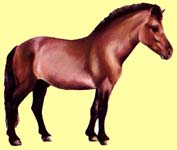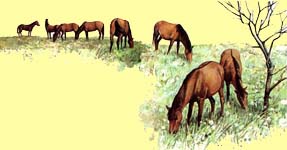|
|
Tarpan |
|
|
|
Tarpan |
|
 The Tarpan is a breed over which there rages heated argument. Up to 1870, there were a number of wild herds of steppe Tarpan in Eastern Europe, Bialowieza, the Caucasus and further into Russia. In 1879 the last wild Tarpan had been killed near Askanio-Nova and in 1887 the last animal in captivity died. At this time, Polish authorities collected from the peasant farms a number of animals which bore all the necessary qualifications and put them into the Forest Reserves at Bialowieza and Popielno.
The Tarpan is a breed over which there rages heated argument. Up to 1870, there were a number of wild herds of steppe Tarpan in Eastern Europe, Bialowieza, the Caucasus and further into Russia. In 1879 the last wild Tarpan had been killed near Askanio-Nova and in 1887 the last animal in captivity died. At this time, Polish authorities collected from the peasant farms a number of animals which bore all the necessary qualifications and put them into the Forest Reserves at Bialowieza and Popielno.
The peasants had been in the habit of catching the steppe Tarpan when they required cheap ponies on their holdings. It is argued that these horses are not true Tarpans, but none the less, they are remarkably alike in all respects: they are extremely fertile, and they may change their coats to white in winter, like other true feral animals when subjected to arctic conditions.
Locality: Poland--Popielno, Bialowieza, Haras Hubno, Grojec.
Color & Characteristics: Brown and mouse dun with dorsal stripe, dark mane and tail, intermingled silver hairs, sometimes stripes on forelegs and inner thighs; coat may change to white in winter. Long head slightly concave face, bulging at nostrils; longish ears; short, thick neck; good shoulders; long back; sloping quarters; fine legs. Very fertile. Height: about 13.3 hands high.

The now extinct Tarpan (Equus przewalski gmelini) originated in the area of present day Poland, and is the progenitor of all lightly-built breed now in existence. The last wild living member of the breed died in 1879 in a desperate attempt to avoid capture. The last living Tarpan died in captivity in a Munich zoo in 1887. This was a difficult pony to tame for agricultural use, it aptitudes being well adapted to life in the wild. It was resistant to the harshness of climate, and it was a prolific breeder. The Tarpan had a courageous, independent and intractable temperament.
There were two distinct types of this pony, one that lived on the steppes, and the other lived in forested areas. Both of these strains lived wild in Eastern Europe in the area from Poland to the Ukraine. In a recent attempt to restore this breed, the Polish government commandeered all horse which displayed features similar to those of the Tarpan, and placed them in the forests of Popienlo and Bialowieza. The resulting offspring reported to be similar to the original Tarpan.
The mesomorphic pony stands about 13 hands at the withers, and its coat may be mouse dun, yellow dun, or palomino. There is a black eel stripe down the center of its back, and a black mane and tail, and it may have black or zebra-marked legs. It has a rather heavy head with a slightly convex profile, and long ears which point forward and slightly to the side. The eyes are small and almond-shaped, and it has a thick forelock. The short, thick neck has a full mane, and the withers are not prominent. It has a long and straight back, a sloping croup, and a tail that is well set-on and flowing. The chest is deep and the shoulder is nicely sloping. Its slender legs are strong.
For more information on the Tarpan, visit:

|
© 1992-2018 NW Breyer Horse Club & Refiner of Gold Creations Equinealities in place since 1997, Section in place 2001, Updated 2/19/2018 |



|
| ||

|
|||||